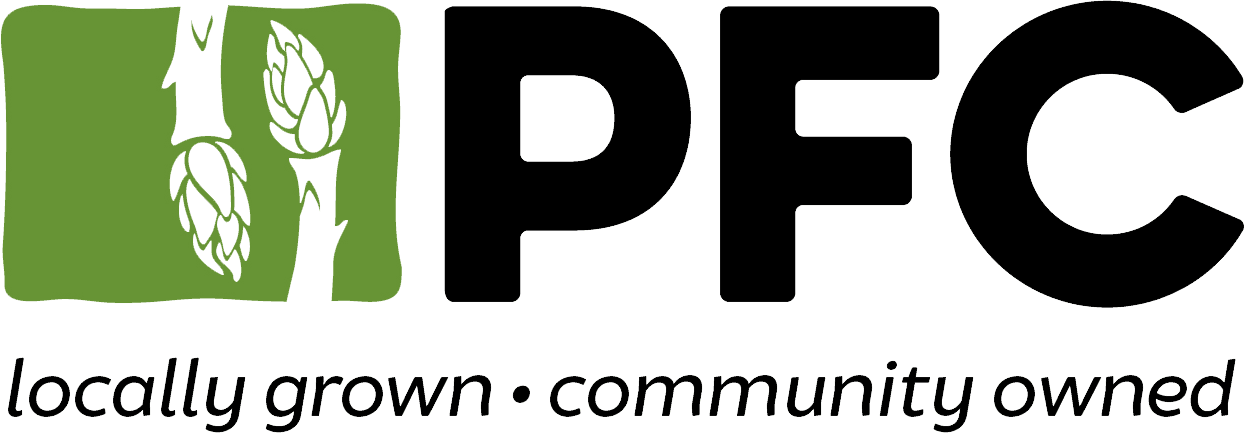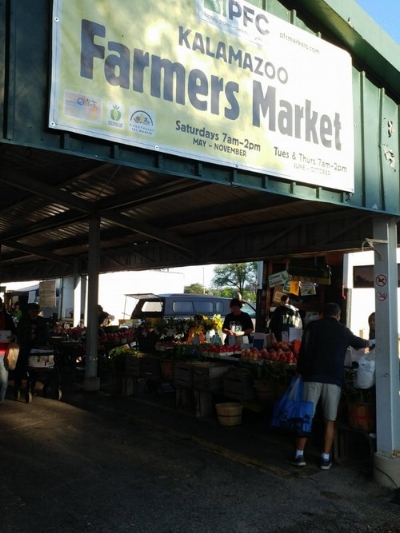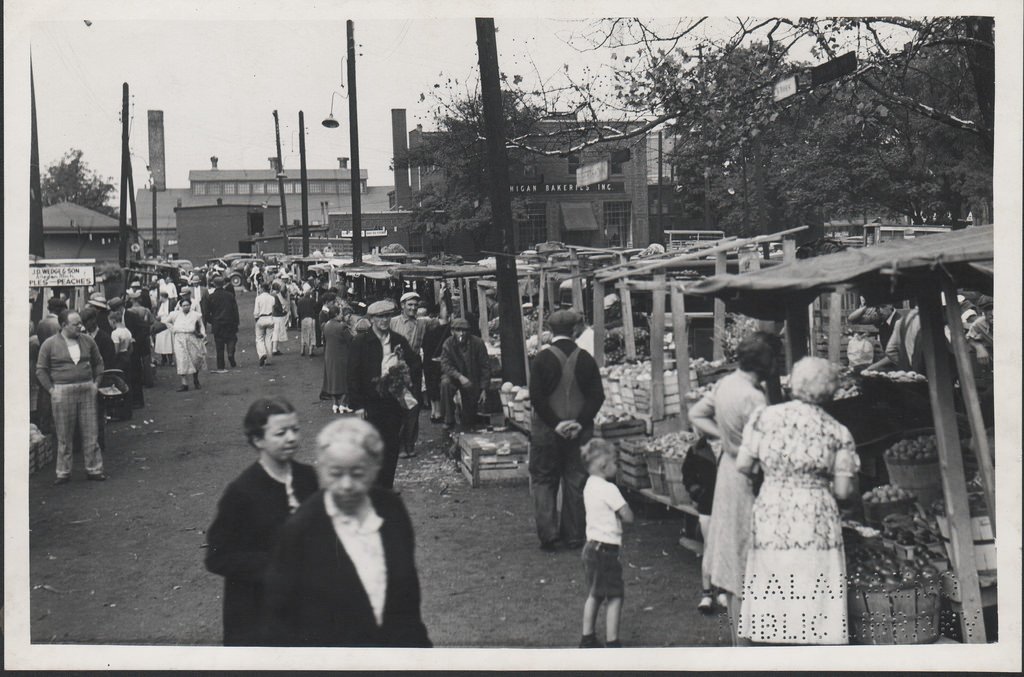Purpose
The purpose of the Kalamazoo Farmers Market is to connect customers and market businesses through honest relationships & supporting community and local economies through a thriving market culture.
We accept many forms of currency, including Food Assistance benefits to ensure the products of our market are accessible to more people in our community.
We always encourage market customers to respectfully ask about their food and food sources, and we always be more transparent with the information we collect and share with the public. Please use this website to learn more about the businesses in our market and the food they create.
Thank you for your support of our Markets!
History
The Kalamazoo City Market on Mills Street, 1936-1941. The original caption reads, "Kalamazoo City Market for farmers to sell produce".
From the City of Kalamazoo's records management, research and archives department:
"The City of Kalamazoo's City (or Farmers') Market's roots were established in the mid 1800's when the City operated a hay market on East Water Street where the City Weighmaster officiated. In 1887, the City Council approved $4,500 to purchase the wood and hay market. During World War I, the City provided small lots of wood and coal at near cost to residents of the City. This market (the Municipal Fuel Yard in 1918) was exceedingly popular as the Army's demand for all products sent costs soaring.
In 1913 the City accepted the use of a lot owned by the Little Brothers for a Market. After a couple of years of haggling the Market opened on North Rose Street. The City also operated a fish market in the late teens.
The first Market Ordinance (#376) in 1916, dealt with the operation of the Kalamazoo Municipal Market. At that time the Market was divided into the retail market on North Rose from Kalamazoo Avenue to the Michigan Central Railroad and the wholesale market which occupied the North side of Kalamazoo Avenue from Rose to Church. The retail market was for producers and growers and the wholesale market was populated by "hucksters" or resellers.
Beginning in 1922 the Market was operated on the "carnival grounds" or "Bixby Lot" on Portage Street at Grace (now Gibson.) After two years of renting this lot the City sought a more permanent arrangement. When negotiations to purchase it failed, the Market was relocated to the Northeast corner of Kalamazoo and Edwards on land rented from William Shakespeare Jr. for $200 per year.
Even after leasing additional land the Shakespeare lot proved inadequate by 1930. The Chamber of Commerce recommended moving the Market and the 1930 season opened opposite the City Light Plant on Mills, with Mr. DeKorte as Market master. A second ordinance (#43) was approved in 1932. For 18 seasons the Market prospered on Mills Street expanding with a Lunch Room and a Fruit Stand in 1931. 1931 also saw a tent erected on the grounds. Bt 1935, the City had constructed a comfort station (restroom) for the Market and Mrs. Sanford and Mrs. Slater leased a restaurant on the premises.
Ordinance #179 was passed in 1941 and in 1945 the Market restaurant was reopened. With the City Light Plant under constant scrutiny for possible sale in the 1940's (even the Commissioners ran on pro and anti Light Plant slates,) the City began acquiring the Bank Street locale for the Market in 1946. It opened on 10/4/1947 at a total cost of $78,000. Claude Van Buskirk was Market master and a restaurant was leased at the new site. Mildred McGuire ran the restaurant in 1949.
Like so much in the 1960's, the City Market changed. In 1963 the Commission approved the construction of a model home at the Market. 1966 brought Ordinance #740. Marilyn Edlund began operating a flea market at the Market in 1968. In the 1970's the City operated another Market at the airport.
In 1975 Marilyn Edlund was appointed Market master. 1970 through 1976 saw Christmas tree sales on the site. In 1979 the supervision of the Market passed from the Buildings Department to Parks and Recreation. Historically, the flea market operated Monday-Wednesday-Friday and the City Market operated Tuesday-Thursday-Saturday. Also in the 1970's resolutions replaced ordinances as the way new market rules were promulgated
In 1982, just as in 1974 and 1978, as part of a downtown revitalization plan, moving the Market was proposed by the City Manager, calling for a "European Style" market to be constructed on the present Arcadia Festival Site. Neighborhood and community leaders opposed moving the Market from its Bank Street location and it remains there today, 62 years after opening in 1947."
Today
In 2013, the People’s Food Co-op of Kalamazoo began serving as operator of the Kalamazoo Farmers Market in partnership with the City of Kalamazoo and the community of vendors. A few things PFC introduced introduced in the first couple of years include:
The use of new signage designating whether a vendor is a Grower, Retailer, Producer or Artisan, giving customers a base level of transparency.
Improvements to placemaking with the addition of live music and food trucks.
Opening up a pedestrian courtyard that added 40 vendor spaces and diversified the market.
All of these changes helped us to be ranked #24 on the 101 Best Farmers Markets in 2014.
In 2016, PFC assisted with the launch and development of the Portage Market, which is now operated by the City of Portage.
We occasionally pop up at Western Michigan University to bring the market to students who may not have the transportation or time to make it on a Saturday,
What's next? Stay tuned for more, and feel free to contact us with ideas and suggestions!
!Thanks for visiting our website. You're using a very old browser and it's preventing this website from displaying correctly. To view this website, please upgrade your browser.



